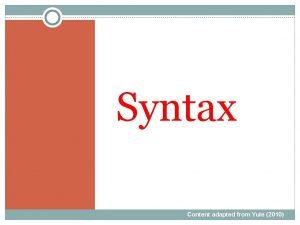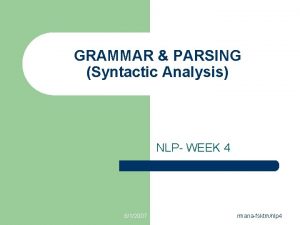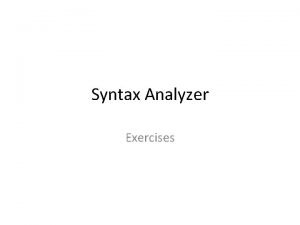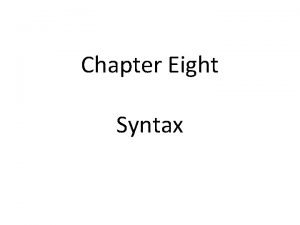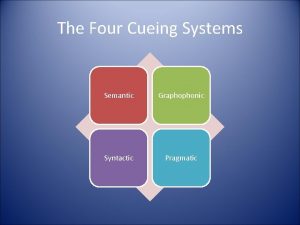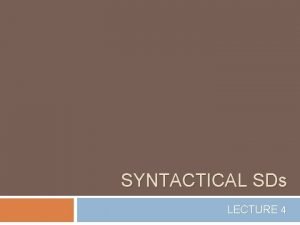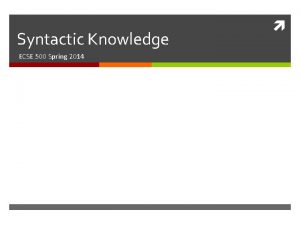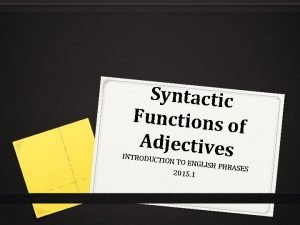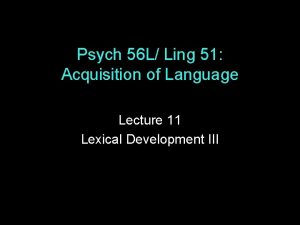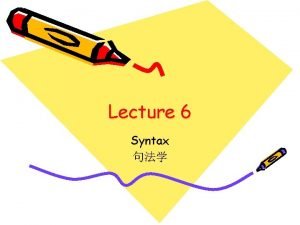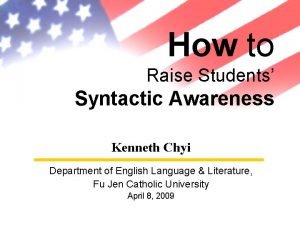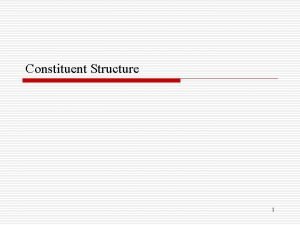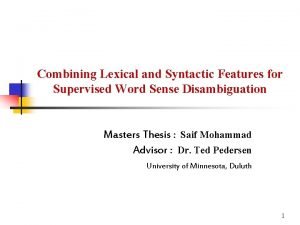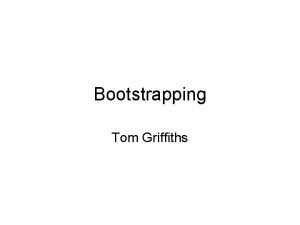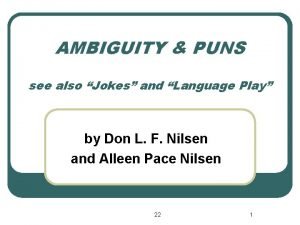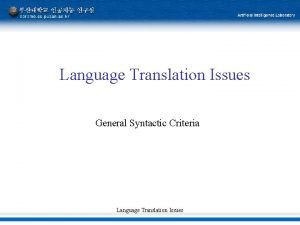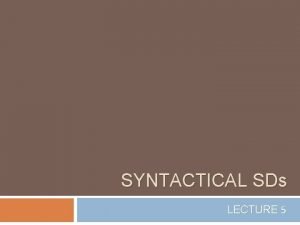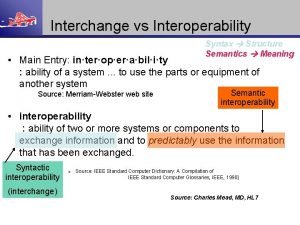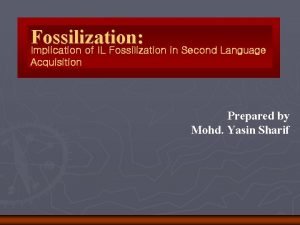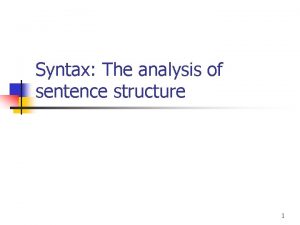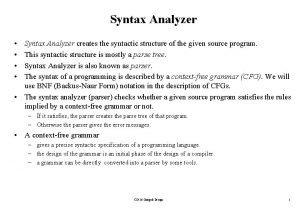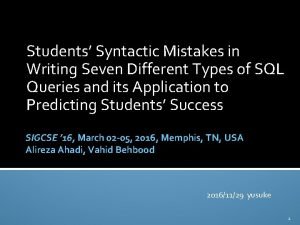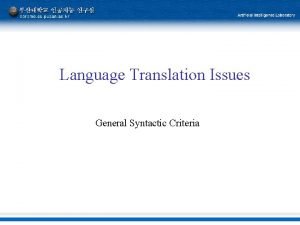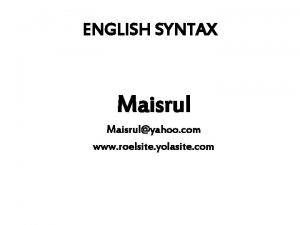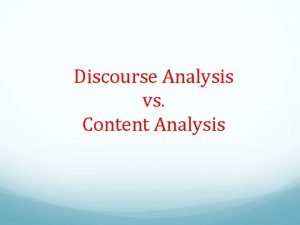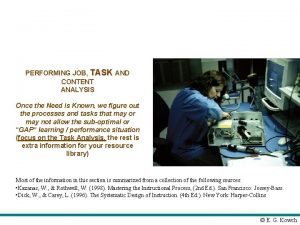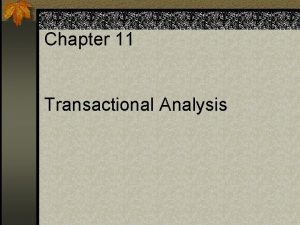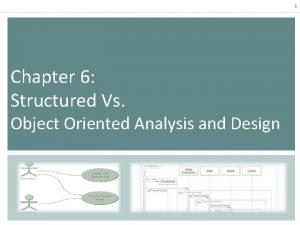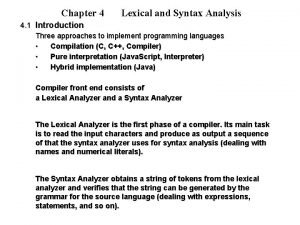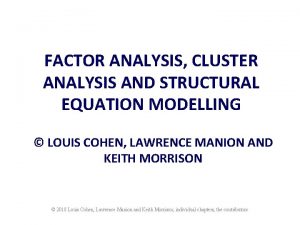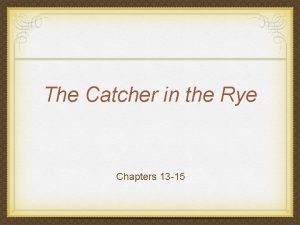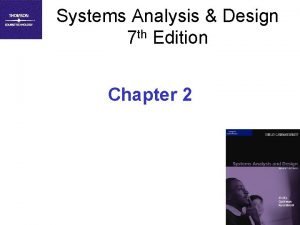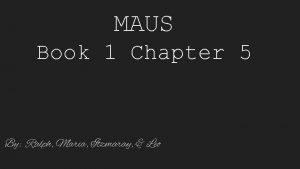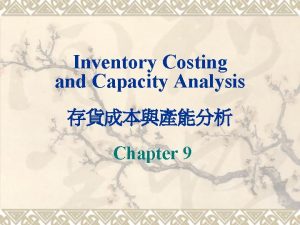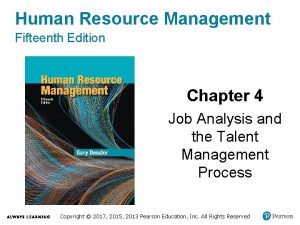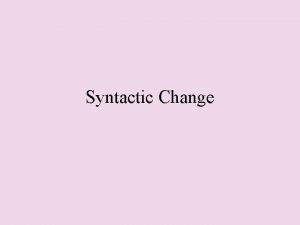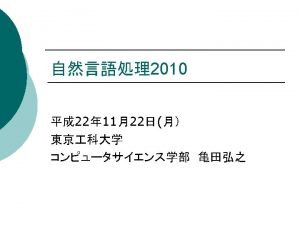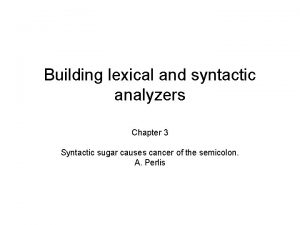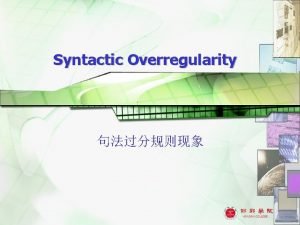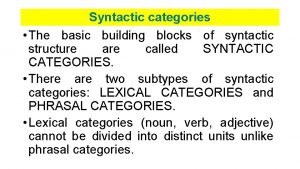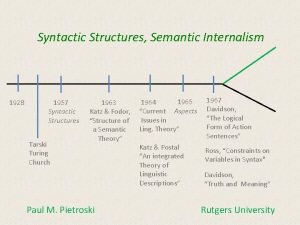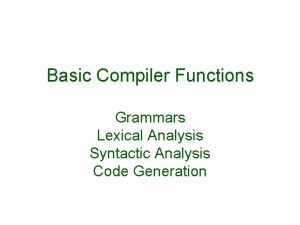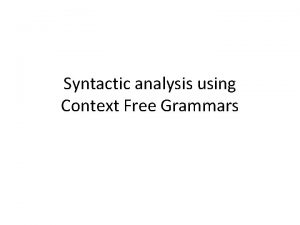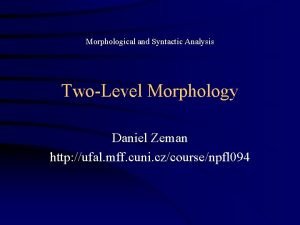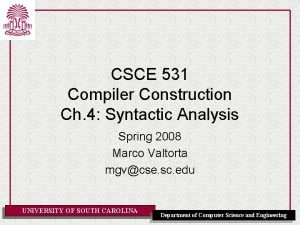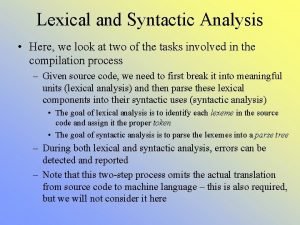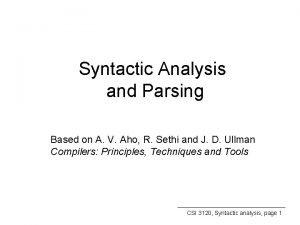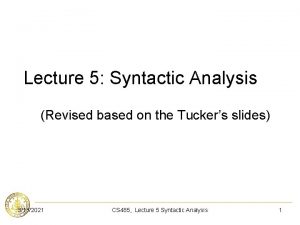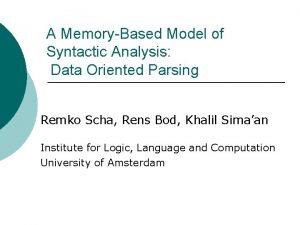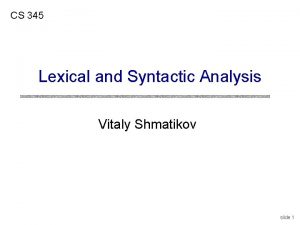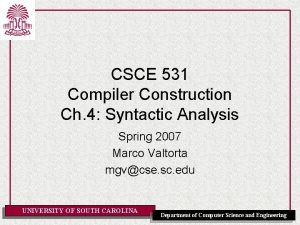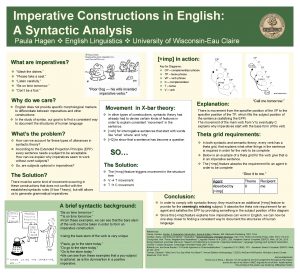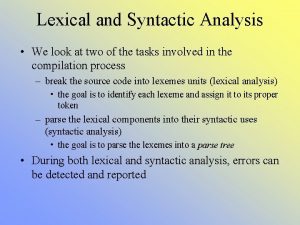Chapter 4 Syntactic Analysis II Chapter 4 Syntactic























































- Slides: 55

Chapter 4 Syntactic Analysis II Chapter 4 -- Syntactic Analysis II

1. Introduction to Bottom-Up parsing v Grammar: E--> E+E | E*E | i v Expression: i+i*i v Rightmost derivation: § § § E =>E+E E=> E+E*E E=>E+E*i E=>E+i*i E=>i+i*i Chapter 4 -- Syntactic Analysis II 2

1. 1 Parsing with a Stack v We will push tokens onto the stack until we see something to reduce. This something is called a "handle" § This is known as shifting and reducing. v Def: a handle is a right hand side of a production that we can reduce to get to the preceding step in the derivation. Chapter 4 -- Syntactic Analysis II 3

§ We carry out the reduction by popping the right hand side off of the stack and pushing the left hand side on in its place. § Notice: a handle is not just any right-hand side; it has to be the correct one -- the one that takes us one step back in the derivation. Chapter 4 -- Syntactic Analysis II 4

1. 2 More about Handles § The bottom up parser's problem is to find a way of detecting when there is a handle at the top of the stack. If there is, reduce it; otherwise shift. § For this reason bottom up parsers are often called shift-reduce parsers § When selecting handles, some things may be the right hand side, but may not be handles. Chapter 4 -- Syntactic Analysis II 5

2. The Operator-Precedence Parser v This is the simplest bottom-up parser (and the least powerful parser for CFG's) v It is generally simpler to construct v table entities consist of <. , =, and. > v handles look like <. ====. > Chapter 4 -- Syntactic Analysis II 6

2. 1 A Simple Operator-Precedence Parser v Grammar: § § v Table: E -> E + E |E*E |(E) |i Chapter 4 -- Syntactic Analysis II 7

v Algorithm: § § Push a $ on stack and append $ to end of input repeat § § § § x=top teminal on stack, y is incoming Find table relationship (x, y) if x<. y or x=y, then shift. if x. >y there is a handle on stack (<. to. >) Reduce & push LHS of production on stack. If the table entry is blank, or handle is not a RHS, there is an error. until x = $ and y = $ or an error is found Chapter 4 -- Syntactic Analysis II 8

v Parse: i+i*i Chapter 4 -- Syntactic Analysis II 9

Chapter 4 -- Syntactic Analysis II 10

v Parse: (i+i)i Chapter 4 -- Syntactic Analysis II 11

Chapter 4 -- Syntactic Analysis II 12

v Parse: ( ) Chapter 4 -- Syntactic Analysis II 13

Chapter 4 -- Syntactic Analysis II 14

2. 2 Forming the Table v Grammar Restrictions § § 1. There must never be 2 or more consecutive non-terminals on the right hand side. 2. No 2 distinct non-terminals may have the same right hand side. 3. For any 2 terminals at most 1 of <. , =, or. > may hold 4. No e productions Chapter 4 -- Syntactic Analysis II 15

v Rules for building the table: § § If a has higher precedence than b, then a. >b and b<. a, regardless of the associativity. If a and b have equal precedence, then relations depend upon associativity. § § If left associative a. >b and b. >a If right associative a<. b and b<. a Chapter 4 -- Syntactic Analysis II 16

v Rules for building the table (cont. ): § Paired operators like ( ) or [ ] are related by = § § § We force the parser to reduce expressions inside these operators by having ( <. a and a. >) Similarly we force the parser to reduce ( E ) before shifting any other terminals by having a <. ( and ). >a, where a is any terminal that may legally precede ( or follow ) Chapter 4 -- Syntactic Analysis II 17

v Rules for building the table (cont. ): § For identifiers, i. >a and a<. i, § § where a is any terminal that may legally precede or follow an identifier. End markers have lower precedence than any other terminal. Chapter 4 -- Syntactic Analysis II 18

3. The LR Parser v The most powerful of all parsers that we will consider (Knuth, 1965) v They can handle the widest variety of CFG's (including everything that predictive parsers and precedence parsers can handle) v They work fast, and can detect errors as soon as possible. (as soon as the first incorrect token is encountered) Chapter 4 -- Syntactic Analysis II 19

v It is also easy to extend LR parsers to incorporate intermediate code generation. v Def: LR(k) -- Left to right scan of the tokens, Rightmost derivation, k-character lookahead. v The larger the lookahead (k) the larger the table. v Hopcroft and Ullman (1979) have shown that any deterministic CFL can be handled by an LR(1) parser, so that is the kind we will learn. Chapter 4 -- Syntactic Analysis II 20

v Table Layout: § § § states | <- Terminals -> | <- Non-Terminals -> -------------------------0 | | 1 | Action | go-to 2 | part. . . | | v LR Parser tables tend to be large. For economy, we don't place the productions themselves in the table; instead, we number them and refer to them in the table by number. Chapter 4 -- Syntactic Analysis II 21

§ § place $ at end of input, state 0 on stack. Repeat Until input is accepted or an error § § § Let qm be the current state (at the top of the stack) and let ai be the incoming token. Enter the action part of the table; X=Table[ qm, ai] Case X of • Shift qn: Shift (that is, push) ai onto the stack and enter State qn. (We mark the fact that we have entered that state by pushing it onto the stack along with ai • Reduce n: Reduce by means of production #n. (We do the reduction in essentially the same was as in the operatorprecedence parser, except for managing the states. ) When the left-hand side has been pushed, we must also place a new state on the stack using the go-to part of the table. • Accept: parse is complete • Error: Indicate input error Chapter 4 -- Syntactic Analysis II 22

v The only complicated thing is reducing. § § 1. If the right hand side of the indicated production has k symbols, pop the top k things off the stack (that is, k state-symbol pairs). This is the handle. If the right hand side is epsilon, nothing is popped. ) 2. Next, note the state on the top of the stack (after the handle has been popped). Suppose it is qj. 3. Suppose the left-hand side is X. Enter the goto part of the table at [qj, X] and note the entry. It will be a state; suppose it is qk 4. Push X and the new state qk onto the stack. Chapter 4 -- Syntactic Analysis II 23

v We will use our familiar grammar for expressions: (with productions numbered) § § § § (1) E -> E + T (2) E -> E - T (3) E -> T (4) T -> T * F (5) T -> T / F (6) T -> F (7) F -> ( E ) (8) F -> I Chapter 4 -- Syntactic Analysis II 24

v Parse (i+i)/i Chapter 4 -- Syntactic Analysis II 25

Chapter 4 -- Syntactic Analysis II 26

v Parse i*(i-i Chapter 4 -- Syntactic Analysis II 27

Chapter 4 -- Syntactic Analysis II 28

3. 1 Construction of LR Parsing Tables v It is customary to cover the generation of LR parsing tables in a series of stages, showing three levels of LR parsers of increasing complexity. § § § (1) Simple LR (SLR) (2) the canonical LR parser, and (3) the lookahead LR (LALR) parser. Chapter 4 -- Syntactic Analysis II 29

v This approach leads us into the subject by gradual stages, each building on the previous one, until we reach the LALR parser, the most practical one, which is impossibly complicated if presented without the background provided by the other 2. v Let’s begin by introducing items that will be common for all three parsers. Chapter 4 -- Syntactic Analysis II 30

v Parser States § In the LR parsers, each current state corresponds to a particular sequence of symbols at the top of the stack § States in a FSA do two things. They reflect what has happened in the recent past, and they control how the FSA will respond to the next input. § Hence, in the design of an LR parser, we must relate the state transition to what goes onto the stack. Chapter 4 -- Syntactic Analysis II 31

v Items § § An item is a production with a placeholder (. ) telling how far we have gotten. The production E-> E+T gives rise to the following items. § § § [E->. E+T] [E->E+. T] [E->E+T. ] symbols to the left of the. are already on the stack; the rest is yet to come. Chapter 4 -- Syntactic Analysis II 32

v So, putting it all together: § § § An item is a summary of the recent history of the parse. An LR parser is controlled by a finite-state machine. The recent history of a finite-state machine is contained in its state. . . So an item must correspond to a state in a LR parser Chapter 4 -- Syntactic Analysis II 33

v Almost, If we have a state for each item we basically have an NDFA. Getting the LR states parallels getting the DFA from the NDFA. v We need to tell the parser when to accept. For this we add a new "dummy" Non-Terminal Z -> E instead of reducing this production, we accept. Chapter 4 -- Syntactic Analysis II 34

v State Transitions § Transitions are determined by the grammar and the item sets obtained from it. § If we have 2 items P=[F->. (E)] and Q=[F->(. E)], then the structure of the items dictates that we have a transition on the symbol ( from P to Q. Chapter 4 -- Syntactic Analysis II 35

v Constructing the State Table § State 0 § § 1. put Z ->. E into the set 2. for all items in the set, if there is a. before a Non. Terminal include all their initial items. (initial items are where the N-T -->. stuff (note the. is first) 3. Apply 2 until nothing can be added. for every item in a state C->a. Xb § § move the. past X perform closure Chapter 4 -- Syntactic Analysis II 36

v Our Language Example. -- by hand § § § § § (0) Z -> E (1) E -> E + T (2) E -> E - T (3) E -> T (4) T -> T * F (5) T -> T / F (6) T -> F (7) F -> ( E ) (8) F -> I Chapter 4 -- Syntactic Analysis II 37

v Our Language Example. -- by hand § 0: § § § § § Z ->. E E ->. E+T E ->. E-T E ->. T T ->. T*F T ->. T/F T ->. F F ->. (E) F ->. i Chapter 4 -- Syntactic Analysis II 38

§ 1: (move over E from 0) § § § Z -> E. E -> E. +T E -> E. -T § 4: (move over '(' from 0) § § § 2: (move over T from 0) § § E -> T. T -> T. *F T -> T. /F § § § 3: (move over F from 0) § T -> F. § § Chapter 4 -- Syntactic Analysis II F -> (. E) E ->. E+T E ->. E-T E ->. T T ->. T*F T ->. T/F T ->. F F ->. (E) F ->. i 39

§ 5: (move over i from 0) § § F -> i. § 6: (move over '+' from 1) § § § E -> E+. T T ->. T*F T ->. T/F T ->. F F ->. (E) F ->. i 7: (move over '-' from 1) § § § E -> E-. T T ->. T*F T ->. T/F T ->. F F ->. (E) F ->. i 8: (move over '*' from 2) § § § Chapter 4 -- Syntactic Analysis II T -> T*. F F ->. (E) F ->. i 40

§ 9: (move over '/' from 2) § § § § T -> T/. F F ->. (E) F ->. i 11: (over T from 6) § § § 10: (move over E from 4) § § F -> (E. ) E -> E. +T E -> E. -T § 12: (over T from 7) § § (over T from 4) -- same as 2 (over F from 4) -- same as 3 § T -> T*F. 14: (over F from 9) § § E -> E-T. T -> T. *F T -> T. /F 13: (over F from 8) § § E -> E+T. T -> T. *F T -> T. /F T -> T/F. 15: (over ')' from 10) § Chapter 4 -- Syntactic Analysis II F -> (E). 41

Chapter 4 -- Syntactic Analysis II 42

v Our Language Example: Yacc grammar § E § : E Plus. Tok T § | E Minus. Tok T § |T § ; § T § : T Times. Tok F § | T Divide. Tok F § |F § ; § F § : LParen. Tok E RParen. Tok § | IDTok § ; Chapter 4 -- Syntactic Analysis II 43

v Yacc output with states § state 0 § § § § $accept : _E $end IDTok shift 5 LParen. Tok shift 4. error E goto 1 T goto 2 F goto 3 § state 1 § $accept : E_$end E : E_Plus. Tok T E : E_Minus. Tok T $end accept Plus. Tok shift 6 Minus. Tok shift 7. error Chapter 4 -- Syntactic Analysis II 44 § § §

§ state 2 § § § § E : T_ (3) T : T_Times. Tok F T : T_Divide. Tok F Times. Tok shift 8 Divide. Tok shift 9. reduce 3 § § § state 3 § § state 4 § T : F_ (6). reduce 6 § § state 5 § § § F : LParen. Tok_E RParen. Tok IDTok shift 5 LParen. Tok shift 4. error E goto 10 T goto 2 F goto 3 F : IDTok_ (8). reduce 8 state. . . Chapter 4 -- Syntactic Analysis II 45

v Filling the Rows of the State Table § State 0: Chapter 4 -- Syntactic Analysis II 46

v Creating Action Table Entries § The shift entries are taken from the state table entries we just created. (terminals we moved across to get the next state). § If a state, q, contains a completed item n: [C->b. ] then for all inputs, x, in the Follow(C) reduce n is in [q, x] § If State q contains [Z -> E. ] then the action for [q, $] is "accept" Chapter 4 -- Syntactic Analysis II 47

Chapter 4 -- Syntactic Analysis II 48

3. 2 Error Handling v For each empty slot in your table, you can have a unique error message. v You could also try to guess what they left out. v Panic Mode -- ignore everything until a ; Chapter 4 -- Syntactic Analysis II 49

3. 3 Conflicts v If a grammar is not LR it will show up in the creation of the table. v No ambiguous grammar is LR. Chapter 4 -- Syntactic Analysis II 50

3. 4 Canonical LR Parsers v The SLR parser breaks down with a conflict. v LR(1) item sets § § standard item sets plus a lookahead symbol this creates a lot more states. It is possible to have |LR(0) item set| * |terminals| Chapter 4 -- Syntactic Analysis II 51

3. 5 Lookahead LR (LALR) Parsers v Why not just use the LR(0) item sets and only add a look ahead when we need one? v They are as powerful as Canonical LR parsers. v They are slower to detect errors (but will detect one before the next token is shifted onto the stack) Chapter 4 -- Syntactic Analysis II 52

v Two ways to construct these: § 1. Brute Force LALR Parser Construction § § Start with the LR(1) item sets and merge states. 2. Efficient LALR Parser Construction § Start with the LR(0) item sets and add lookaheads as needed. Chapter 4 -- Syntactic Analysis II 53

3. 6 Compiler-Compilers v YACC generates LALR(1) parser code § When it runs into conflicts it notifies the user § shift/reduce conflicts are resolved in favor of the shift. § operators are right associative by default Chapter 4 -- Syntactic Analysis II 54

4. Summary: Which Parser Should I Use? v We have seen several different parsing techniques, of which the most realistic are probably the table driven parsers. (predictive, operator precedence, and LR) v Which is best? -- it seems to be personal taste. v Now that Yacc-like parser generators are available, the LR parser seems to be the inevitable choice, but, a lot of people still write predictive, recursive-descent parsers. Chapter 4 -- Syntactic Analysis II 55
 The boy saw the man with the telescope
The boy saw the man with the telescope 812007
812007 Syntactic analysis exercises
Syntactic analysis exercises Symbols used in syntactic analysis
Symbols used in syntactic analysis Lexical and syntactic ambiguity
Lexical and syntactic ambiguity Pragmatic cueing system examples
Pragmatic cueing system examples Syntactical stylistic devices
Syntactical stylistic devices Syntactic knowledge
Syntactic knowledge Syntactic function of adjectives
Syntactic function of adjectives Semantic patterning example
Semantic patterning example Syntactic bootstrapping
Syntactic bootstrapping What is syntax?
What is syntax? Syntactic awareness definition
Syntactic awareness definition Structural syntactic categories
Structural syntactic categories Syntactic features
Syntactic features Syntactic features
Syntactic features Syntactic bootstrapping
Syntactic bootstrapping Lexical ambiguity jokes
Lexical ambiguity jokes General syntactic criteria of a programming language
General syntactic criteria of a programming language Syntactical stylistic devices
Syntactical stylistic devices Syntactic interoperability vs semantic interoperability
Syntactic interoperability vs semantic interoperability Language fossilization definition
Language fossilization definition Syntax
Syntax Left factoring
Left factoring Syntactic mistakes
Syntactic mistakes Syntactic criteria
Syntactic criteria Five signals of syntactic structure
Five signals of syntactic structure Syntactic sugar causes cancer of the semicolon
Syntactic sugar causes cancer of the semicolon Structured analysis
Structured analysis Cuckoo sandbox online
Cuckoo sandbox online Content analysis and discourse analysis
Content analysis and discourse analysis Difference between error analysis and contrastive analysis
Difference between error analysis and contrastive analysis Types of intralingual errors
Types of intralingual errors Fact finding techniques in sad
Fact finding techniques in sad Content analysis and task analysis
Content analysis and task analysis Parent ego state
Parent ego state Ooad vs oop
Ooad vs oop Syntax and lexical analysis
Syntax and lexical analysis Content analysis is a type of secondary data analysis
Content analysis is a type of secondary data analysis Feasibility study in system analysis and design
Feasibility study in system analysis and design Difference between factor analysis and cluster analysis
Difference between factor analysis and cluster analysis Things fall apart 4-6 summary
Things fall apart 4-6 summary Great gatsby chapter eight summary
Great gatsby chapter eight summary Great gatsby chapter 3
Great gatsby chapter 3 What are two incidents involving automobiles in chapter 3
What are two incidents involving automobiles in chapter 3 Corruption in the great gatsby chapter 3
Corruption in the great gatsby chapter 3 What is the setting in chapter 2 of the great gatsby
What is the setting in chapter 2 of the great gatsby The catcher in the rye chapter 13-15 summary
The catcher in the rye chapter 13-15 summary System analysis and design chapter 2
System analysis and design chapter 2 Summary of ratio analysis
Summary of ratio analysis Maus chapter 6 summary
Maus chapter 6 summary Lord of the flies chapter 8 and 9 summary
Lord of the flies chapter 8 and 9 summary Lord of the flies chapter 4 summery
Lord of the flies chapter 4 summery Lord of the flies chapter 11
Lord of the flies chapter 11 Chapter 9 inventory costing and capacity analysis
Chapter 9 inventory costing and capacity analysis Chapter 4 job analysis and the talent management process
Chapter 4 job analysis and the talent management process
